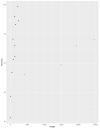Artificial Intelligence in Laryngeal Endoscopy: Systematic Review and Meta-Analysis
- PMID: 35628878
- PMCID: PMC9144710
- DOI: 10.3390/jcm11102752
Artificial Intelligence in Laryngeal Endoscopy: Systematic Review and Meta-Analysis
Abstract
Background: Early diagnosis of laryngeal lesions is necessary to begin treatment of patients as soon as possible to preserve optimal organ functions. Imaging examinations are often aided by artificial intelligence (AI) to improve quality and facilitate appropriate diagnosis. The aim of this study is to investigate diagnostic utility of AI in laryngeal endoscopy.
Methods: Five databases were searched for studies implementing artificial intelligence (AI) enhanced models assessing images of laryngeal lesions taken during laryngeal endoscopy. Outcomes were analyzed in terms of accuracy, sensitivity, and specificity.
Results: All 11 studies included presented an overall low risk of bias. The overall accuracy of AI models was very high (from 0.806 to 0.997). The accuracy was significantly higher in studies using a larger database. The pooled sensitivity and specificity for identification of healthy laryngeal tissue were 0.91 and 0.97, respectively. The same values for differentiation between benign and malignant lesions were 0.91 and 0.94, respectively. The comparison of the effectiveness of AI models assessing narrow band imaging and white light endoscopy images revealed no statistically significant differences (p = 0.409 and 0.914).
Conclusion: In assessing images of laryngeal lesions, AI demonstrates extraordinarily high accuracy, sensitivity, and specificity.
Keywords: accuracy; artificial intelligence; laryngoscopy; larynx; lesion; sensitivity; specificity.
Conflict of interest statement
The authors declare no conflict of interest.
Figures






References
Publication types
LinkOut - more resources
Full Text Sources

